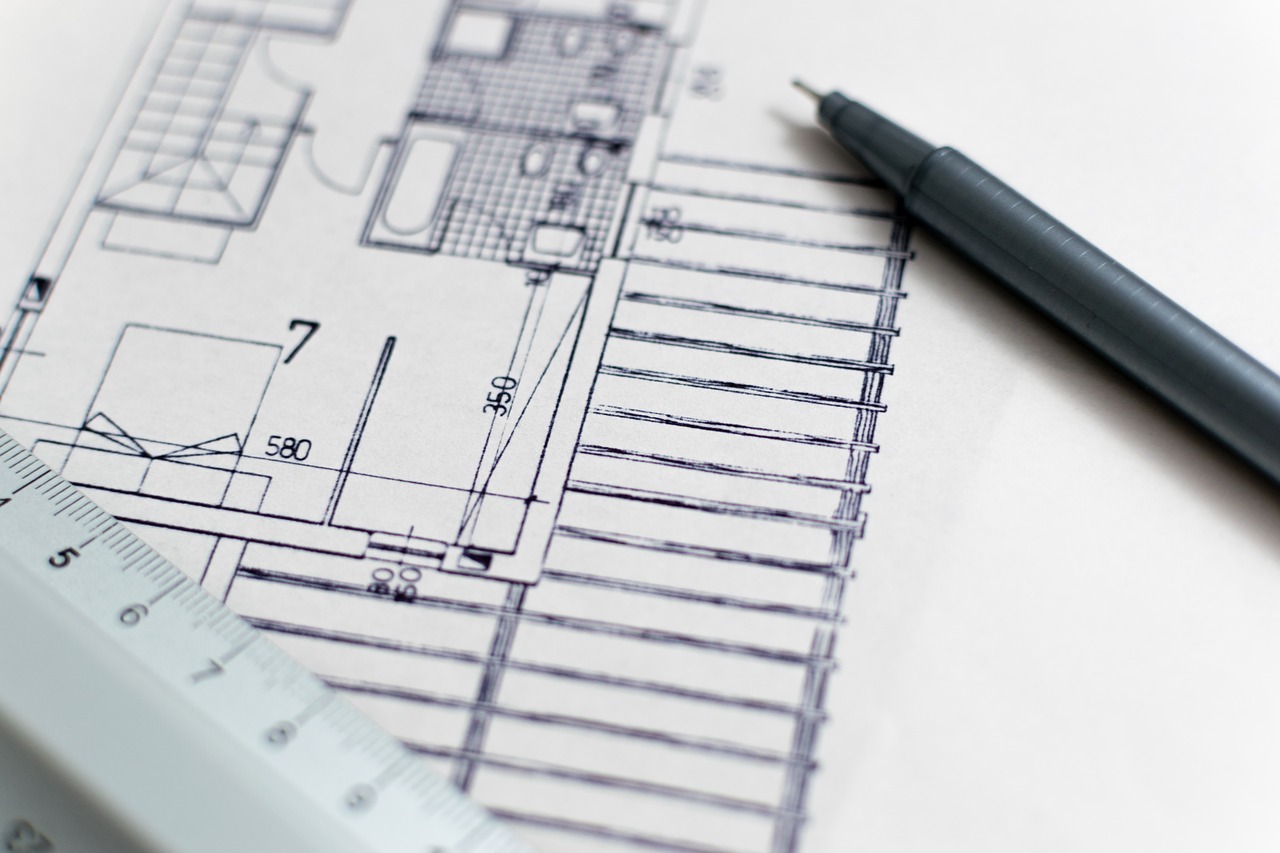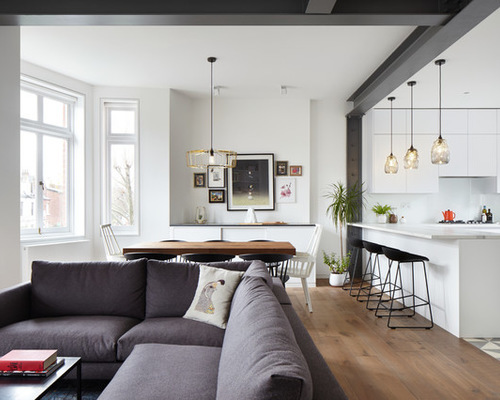8 Ways to Make the Most of the Home You Have


“Staying Put” by architect and writer Duo Dickinson is not your typical architect’s book about design. There’s no obscure language nor design-for-design’s-sake ideas. It is a practical, down-to-earth guide that walks anyone through the rational process of how to remodel your house to get the home you want, from how to think about your house and overcoming hurdles to a list of “Duo’s Do’s and Don’ts” for the homeowner. Along the way, there’s plenty of nice before-and-after photos to help explain the points. Do read the book. You’ll be glad you did.
Read on for eight of Dickinson’s brightest suggestions:
Consider the compass points. The tips and illustrated examples are wonderfully straightforward. For example, we see a house that gets overheated, the siding degrades and the front door bakes in the sun because it all faces south.
Dickinson’s common-sense advice: Rework the front of the house with a new wide porch that shades the front door and some smaller, yet well-sized windows to create a lot more curb appeal while reducing maintenance and energy consumption. It’s a triple win: more beauty and comfort with less cost.
Avoid gutters. Statements such as “gutters and leaders are devout to be avoided” may sound like heresy to many, but certainly are the truth. Proving his point, Dickinson illustrates how a properly-built roof overhang can shed all the water it must without the complications, such as ice dams, caused by gutters.
Embrace small moves. Dickinson provides a wealth of simple solutions illustrated with before-and-after photos. He shows how to use small moves for big dividends, such as taking out a wall between a kitchen and a hallway to make room for more kitchen storage.
Enhance curb appeal. The book offers solutions to common problems with a particular style, such as how to improve and enhance an entrance into a split-level home.
Open up to the outside. Dickinson provides some excellent examples of how we can use modern windows and doors to strengthen the connection between inside and outside. Our homes, says Dickinson, no longer need be “later-day caves.”
Find your home. Learning more about the style of the house you have will help you avoid obstacles in remodeling and recognize the best opportunities for improving your particular home.
Open up the inside. Snippets of advice sprinkled throughout the book are like refreshing raindrops that clear the cobwebs away. One such snippet: “If you walk through a room to get to a room, something is wrong.” You know — it’s when that new great room gets added onto a modest house, and the result is some kind of dyslexic creature that’s really two houses rather than one.
So rather than even building an addition, Dickinson suggests you make the most of what you already have. In this example, widening the opening between rooms strengthens this room’s connection with the rest of the home, increasing its utility and spaciousness.
Work with what you’ve got (before): Keeping the kitchen size the same while vaulting the ceiling dramatically increases the overall spaciousness of the room, as you’ll see in the next photo.
Work with what you’ve got (after): Walls, doors, appliances, and even the skylight and kitchen sink were all left where they were. This all avoided costly plumbing, electrical and mechanical work and rework.
Working with what you’ve got (plans): Dickinson has included before-and-after floor plans for many of the examples. These plans help provide that much more context, allowing the reader to better understand what they may be able to do with the home they already have.
By Bud Dietrich AIA
Tips for Moving Into a Smaller Home as a Senior


By Michael Longsdon
For many seniors, there comes a time when the expense and upkeep of a big home no longer seem realistic. All of your kids have moved out, and suddenly, your multi-bedroom house feels excessively large and empty. Plus, it may be difficult to keep up with mortgage payments if you’re expecting a lower income during retirement. Whether downsizing is a financial necessity or an emotional decision, here’s how to tackle the process without getting overwhelmed.
Do Online Research
Before you start looking at houses in person, narrow down your options by doing some research online. Search the local housing market on sites such as Redfin to get a feel for house prices in your desired area. For example, homes in Seattle, Washington have sold for an average of $685,000during the past month. Explore listings in your preferred size range and location so you can come up with a realistic budget for your new home.
Think far ahead as you look at homes, considering the possibility that the needs of you and your spouse may change over time. One-story homes can be much more accessible for you and your friends down the line. You should also take time to research the neighborhood and pay attention to the house’s proximity to grocery stores, leisure centers, and public transportation.
Plan for Your Storage Needs
If you’re moving to an apartment or condo, you may not have the attic, basement, or even the closet space that you’re used to. Look for a nearby for an affordable self-storage unit so you aren’t left crowding boxes and furniture into your new home. Some simple online research can help you find the best deals in your area. In the last 180 days, for instance, self-storage units in Seattle, Washington cost an average of $88.45 per month.
Go Through Your Possessions Methodically
One of the hardest parts about downsizing is getting rid of things you’ve had for decades. Apartment Guide recommends looking at pictures of clutter-free rooms in magazines for inspiration before starting your own purge. This will mentally prepare you for getting rid of all the stuff you don’t need cluttering up your new, smaller space.
As you declutter, go room by room and sort items into no more than five piles: keep, donate, sell, gift, and throw away. Don’t be afraid to let go of things that are useful but not particularly necessary in your own life. Likewise, don’t keep things out of obligation or feelings of guilt. While you’re cutting the clutter, keep a floor plan of your new home nearby so you can plan out your rooms and ensure your furniture will fit. If you’re worried about accurately measuring your space, you can hire a professional to help you out.
Pack Like a Pro
Protect your items during your move and make them easier to unpack later by trying out some expert packing tips. For example, socks make great padding for glasses and mugs, while oven mitts are perfect for transporting knives a little more safely. Secure entire desk drawers and kitchen storage trays with plastic wrap for much faster unpacking later. Also, keep your clothing on hangers and simply slip a garbage bag over them for protection. Remember to pack an essentials box of everything you need during your first day and night in your new house.
Follow a Moving Checklist
There is a lot to remember to do before moving day. For example, you need to update your mailing address with the post office, find a new doctor, and transfer your utilities. Follow a moving checklist (or hire a senior move manager for around $316 per day) to avoid forgetting important tasks. One of your moving tasks should involve researching moving companies at least two months before your move. This gives you plenty of time to find the help you need within your budget. Learn about how to spot rogue moving companies so you can avoid being scammed, especially if you’re moving long distance.
Moving is exhausting for anyone. But moving into a smaller home can be especially emotional as you say goodbye to personal objects that have surrounded you for much of your life. For this reason, it’s important to take things slow while you sort through your possessions and search for the perfect place to spend your golden years.
Mr. Longsdon provides advice to seniors on downsizing and aging in place and can discuss concerns like tackling home accessibility modifications, how to find a great contractor, the benefits of aging in place, and more.
10 Steps to Get Your Home Clean and Ready for Spring


Warmer months are ahead, so now is the time to plan for spring cleaning and maintenance. A clean home offers a fresh start for the year, and a checklist of tasks guides your efforts towards efficiency. For many homeowners, spring cleaning can be a personal challenge. It can also be one accomplished with the help of the rest of the family or other residents. In some occasions, however, professional assistance may be advised, or even necessary. Regardless, regular home maintenance not only increases your home’s value, but it can also make your home more comfortable and enjoyable.
Indoors
Check Your Attic
Once summer arrives, it can be too hot in many regions to comfortably perform an inspection. Use late winter and early spring to ensure the following: there’s ample insulation (10 to 14 inches), there are no signs of mice or rats (droppings, strong odor, nests), there are no bugs (flying, crawling, or otherwise), and there are no signs of roof leaks (water stains, etc.).
Schedule HVAC Maintenance
Annual tune-ups on your heating/cooling equipment will reduce your energy bill and help ensure you can maintain a comfortable indoor temperature.
Fix the Window Screens
It won’t be long before you’ll want to throw open the windows for fresh air, or relief on a warm afternoon. Take time now to ensure your window screens are ready for the challenge. Many traditional neighborhood hardware stores still offer re-screening services. Contractors also specialize in this service and are available for house calls.
Clean the Ceiling Fans
During the warm weather and the cold, ceiling fans can help moderate the temperature and better distribute the air. But your fans will be far more efficient if you give them a good cleaning a couple times each year. For fans mounted up to 10 feet in the air, you can use a ladder to access the tops of the fan blades. For those mounted on vaulted ceilings, use a long-handled duster.
Apply Weather Stripping
Many homeowners think of weather stripping as a cold-weather commodity, but it’s just as important during summer. To keep the cool air in and the hot air out, use any of the many filler materials available to seal gaps around windows, doors, exhaust fans, and any other point where you can see light peeking through.
Outdoors
Look for Damaged Roof Shingles
Use binoculars (with your feet safely planted on the ground) to scan for roof shingles that are curling, broken, or missing. If anything seems compromised, have a roofing company perform an inspection and provide a bid. If you or any members of your family are enterprising drone users, a camera-affixed drone can also be a useful aid in this reconnaissance effort.
Wash the Exterior
An easy way to extend the life of your exterior paint – and make your house look better than ever – is to give the siding a good washing. Use mostly water (to avoid harming any plants) and a stiff pole brush.
Search Out Rotten Wood
While you’re washing the exterior, keep an eye out for areas where there may be rot. Use a screwdriver to gently but firmly press on any siding or trim where you see black mold, missing paint, or exposed gray wood. If the area you’re probing feels mushy or bone-dry, contact a contractor to assess and stabilize the situation.
Clean the Gutters
All it takes is a handful of leaves to clog a gutter downspout and cause overflow and flooding. Hire a professional to give the gutters a thorough cleaning and you’ll avoid the very real dangers of working from a ladder. If you live in an area with lots of trees, consider getting quotes for some of the leaf-less gutter systems.
Prepare Your Lawn to Grow
The winter sets impediments for your lawn, and it takes preparation to help it shine. Rake away any dead grass and aerate the whole lawn to allow nutrients to access the roots. Reseed bare spots and apply a spring fertilizer to ensure your lawn has the fuel it needs to grow strong and beautiful.
Five Ways to Incorporate Pantone’s ‘Living Coral’ Into Your Home


Photo Credit: Pantone Color Institute
Design inspiration comes in many forms, but few carry the cache of the Pantone Color of the Year. For two decades, the Pantone Color Institute has convened to debate and determine an appropriate color that represents the current times. In a tradition harkening to the pageantry and mystique of secret societies, biannual meetings are held in private by color and design experts to determine the appropriate shade for the upcoming year. Through this deliberation, we have been delivered our next design baseline: the 2019 Pantone Color of the Year is Living Coral.
Living Coral is a mesmerizing pinkish hue with a light base that makes it a spectacular pairing with a variety of other options. Evoking the way natural coral often forms a basis for entire, vibrant ecosystems, Living Coral seeks to be eye-catching, while simultaneously drawing attention to what surrounds it. So how can Living Coral be best incorporated into your home this year? We have a few ideas.
Accent Furniture

Photo Credit: Fresh Idees on Pinterest
It can be overwhelming to dive headlong into an entire stylistic renovation. Even a single feature, like a Living Coral colored chair or settee can brighten a space.
Entryway and Living Room Walls

Photo Credit: France and Son on Pinterest
Make a bold first impression by inviting guests into a space that is framed by Living Coral walls on every side.
Subtle Accessories

Photo Credit: HoneyComb Studio on Pinterest
Any room can be brightened by a touch of Living Coral. From coral curtains to stylish gilded vases and accent pillows, there are numerous ways, great and small, to sprinkle this seaside shade throughout your home.
Accent Wall

Photo Credit: Krista4Coral on Instagram
One of our favorite interior design trends pairs perfectly with Pantone’s 2019 selection. Coating one wall with Living Coral is a great way to accent a space without committing to painting an entire room.
Brightened Door

Photo Credit: DesignStudio039 on Instagram
Whether gracing your front door or a unique space in your home, Living Coral inspires an optimistic feeling for what lies beyond.
Do you plan to incorporate Living Coral into your home this year? We’d love to hear about it!
A Beginner’s Guide to Managing a Remodel

Browsing photos and ideas can be a fun part of creating your dream room. But making your designs a reality also takes smart planning and organization. Project management is an essential part of remodeling, and there’s nothing like the feeling of implementing a plan to create something new and beautiful. These tips can help you achieve your desired results.
Find a Local Contractor to Create Your Dream Home

YourSpace Contractors, original photo on Houzz
Become a list writer. Making lists is key when it comes to project management. It’s the only way to properly organize your thoughts and prevent any details from being forgotten.
The most important list is your scope of work, or specifications, document. This is basically a detailed list of everything to be done, from start to finish. If you’re dealing with one main builder who’s organizing all the work, then you’ll need to make sure he or she gets a copy, so the goals are clear and all the information is provided.
Also, having detailed specifications makes it easier if you want to obtain multiple quotes, and you’ll know it’s a fair comparison since all the builders will be quoting using the same criteria.

frenchStef Interior Design, original photo on Houzz
Make sure you’re all on the same page. If you’re coordinating separate subcontractors (cabinetmaker, plumber, electrician), then it would be worth indicating who’s responsible for each task. Give a complete copy of the specifications to all of them, so they’re all aware of what everyone is doing. Discuss the specifications with your subcontractors since they may be able to provide help and advice. A schedule is also useful, so you can keep track of progress and everyone knows who’s going to be on-site on which day.
With prior knowledge that a partition wall will feature some lighting, for instance, the builders will know to leave the stud frame open for the electrician to run the wires through before it’s boarded up and plastered over. Trying to feed wires through after the fact is much harder, takes longer and risks unnecessary damage.

Sian Baxter Lighting Design, original photo on Houzz
Break into subsections. In addition to your main specifications, it’s a good idea to have sublists for each separate element of your design. For example, your main specifications may say “install 6 x recessed LED downlights in ceiling,” but your lighting specifications will detail where they are to be positioned, the type of bulb, the hardware finish and so on. The more information you provide, the more accurate your quote should be and the less likely it will be for mistakes or misunderstandings to occur. It will also minimize any unexpected costs.
This bathroom has a minimalist elegance, but it’s far from straightforward. This project would have required a builder’s spec, including layout and elevation drawings with dimensions, an electrical spec with lighting plan, a plumbing spec with layout drawing, and a decorating spec — phew!
Plan like a pro. Finalize your design before starting any work, rather than trying to do it as you go along. The process will be much more enjoyable without constant deadlines presenting themselves, and if you haven’t planned, you may find your options restricted based on work that’s already taken place.
Take a couple of weeks to put it all together, write your specifications, draw up the plans, get everything ready and make all the decisions before proceeding. This will save you time and money along the way, and significantly reduce stress levels during the project.
This clever design features well-thought-out lighting and custom cabinetry. Careful consideration would have been given to where to position the outlets, radiators, lights, switches and other details.

Yellow Letterbox, original photo on Houzz
Never assume. You know the saying. When writing your specifications or drawing your plans, never assume that someone else will know what you want unless you explicitly state it. Include every tiny detail, no matter how picky it may seem. As well as avoiding mistakes, it also prevents any disputes over what is and isn’t included in the quote.
This bathroom just wouldn’t have looked the same if white grout had been used, for instance. You may think it would be absurd to even consider using white grout in this case, but if you haven’t asked for dark gray, you can’t expect it and you can’t assume that you will be asked what color you want. White is standard, and a tiler may use it if nothing has been specified.
Stand by for decisions. Your builder will present many questions and decisions to you along the way. Which tiles do you want on the walls? Where do you want these wall lights? What color do you want on the baseboards?
Your best bet will be to try to pre-empt as many of these decisions as possible and have the answers ready or, even better, provide the information in advance. Making these decisions under pressure can lead to impulse moves you may regret later. However, taking too long could hold up the project, costing you time, money and the patience of your builder. No one wants an unhappy builder.
Inevitably, there will be some questions you couldn’t have anticipated, but if you communicate well with your contractors, they should, where possible, give you time to make a decision without holding up the project. Don’t be afraid to ask their opinion on the best course of action, but don’t feel pressured to compromise on the design if you don’t want to.

Brilliant Lighting, original photo on Houzz
Give yourself time to deliver. This is one of the classic pitfalls, so take note. When pulling your design ideas together and deciding which products and materials to use, make a note of the lead times. Many pieces of furniture are made to order and can have lead times of up to 12 weeks, sometimes longer. Similarly, tile and natural stone can take much longer than expected to arrive, and products from abroad can encounter holdups during transit.
This chandelier was custom-made for the project and looks fantastic. This is no last-minute, off-the-shelf, next-day-delivery job. It can be a huge shame if you’ve spent hours, days, weeks choosing the perfect product, but when you come to order it, you find that it will take too long to be delivered, perhaps time you can’t afford. Then you have to decide whether to hold up the work or pick something else based on the fact it can be delivered quickly.
Find a Bathroom Vanity for Your Bath Remodel
Factor in a contingency. Even when you have the very best of intentions, issues that you couldn’t have predicted may arise during your project. So it’s a good idea to factor in a 10 percent contingency within your budget for these matters, especially with old buildings. Who knows what condition the walls are in behind those kitchen cabinets before you rip them out? Or what may be lurking underneath that carpet when you pull it up?
In these situations, it’s important to expect the worst and don’t let it throw you off your game. You are a project manager extraordinaire, and you’ve totally got this. Just accept that these things happen, find out what the options are and make a decision. Your contractors will be able to advise on what to do, so harness their expertise and trust them to help you find the right solution.

Elayne Barre Photography, original photo on Houzz
Call in the cavalry. If you choose to manage your project yourself, it’s certainly an enjoyable and rewarding process, but it also takes a certain type of person. You have to be organized, calm under pressure, strategic and confident — not to mention being able to afford the time to plan, coordinate and oversee the work.
If you have qualms about taking it on yourself, then consider hiring a project manager. Yes, there will be a fee, but consider that a badly managed project can cost you time and money, and you may not achieve the results you were after. A pro will take care of everything and allow you to rest easy, knowing you’re in safe hands.
By Jennifer Chong, Houzz
Selling Your Home? Go Through This Safety Checklist With Your Real Estate Agent


Selling your home can be stressful for many reasons. Not only are you trying to get the best financial return on your investment, but you might also be working on a tight deadline. There’s also the pressure to keep your home clean and organized at all times for prospective buyers. One thing you can be sure of when selling your home is that there will be strangers entering your space, so it’s important for you and your agent to take certain safety precautions.
- Go through your medicine cabinets and remove all prescription medications.
- Remove or lock up precious belongings and personal information. You will want to store your jewelry, family heirlooms, and personal/financial information in a secure location to keep them from getting displaced or stolen.
- Remove family photos. We recommend removing your family photos during the staging process so potential buyers can see themselves living in the home. It’s also a good way to protect your privacy.
- Check your windows and doors for secure closings before and after showings. If someone is looking to get back into your home following a showing or an open house, they will look for weak locks or they might unlock a window or door.
- Consider extra security measures such as an alarm system or other monitoring tools like cameras.
- Don’t show your own home! If someone you don’t know walks up to your home asking for a showing, don’t let them in. You want to have an agent present to show your home at all times. Agents should have screening precautions to keep you and them safe from potential danger.
Talk to your agent about the following safety precautions:
- Do a walk-through with your agent to make sure you have identified everything that needs to be removed or secured, such as medications, belongings, and photos.
- Go over your agent’s screening process:
- Phone screening prior to showing the home
- Process for identifying and qualifying buyers for showings
- Their personal safety during showings and open houses
- Lock boxes to secure your keys for showings should be up to date. Electronic lockboxes actually track who has had access to your home.
- Work with your agent on an open house checklist:
- Do they collect contact information of everyone entering the home?
- Do they work with a partner to ensure their personal safety?
- Go through your home’s entrances and exits and share important household information so your agent can advise how to secure your property while it’s on the market.
Your safety, as well as that of your agent and your home, is of paramount importance when selling a property. For more information, visit:
http://www.mercurynews.com/los-gatos/ci_26509084/realtors-issue-safety-tips-folks-who-are-selling
Affordable Tips To Up Your Home’s Curb Appeal


You’ll never have a second chance at a first impression, so let’s make it count! When it comes to upping your home’s curb appeal, there are plenty of small changes you can make that have a big impact. And best of all, you don’t need to call in the pros or spend a fortune to get beautiful results. Below are some helpful and affordable tips.

A Well-Maintained Yard
Mowing: The first step to a well-manicured lawn is to mow it regularly. The experts recommending mowing high because mowing it too short can damage the grass and allow weeds to set root.
Weeds: To prevent weeds like crabgrass use a pre-emergent herbicide in early spring. These herbicides manage the weeds by stopping the seeds from sprouting in your lawn. Broadleaf weeds like dandelions can be stopped by applying granular weed control products.
Feeding: Lawns consume mostly nitrogen, so look for mixes of fast and slow release fertilizers; they will feed your lawn over time while keeping it lush and green.
Watering: Nighttime watering can result in long spans of moisture on the blades, potentially exposing your grass to disease. Consider watering your lawn in the morning – the sun helps dry out the blades throughout the day.
Flowers: You can quickly and affordably dress up your yard with colorful pre-made flower pots and containers. When placing your flower pots and containers remember that asymmetrical arrangements and staggering plants will provided the liveliest setting.

Dress up the Front Door and Porch
Paint: A fresh coat of paint in a pop color can give your home a well-deserved facelift. If you are hesitant to add a bright color to your front door, check out our article Energize Your Home This Winter With Bright Hues.
Replace Old Hardware: Clean off any dirty spots around the door knob, and use a metal polish on the fixtures. Change out house numbers for an updated feel, put up a wall-mounted mailbox, or add an overhead light fixture. Keep in mind that well thought through elements, instead of mix-and-match pieces, will add the most curb appeal.
Create Perfect Symmetry: Symmetry is one of the simplest design techniques to master and is the most pleasing to the eye. Maintain symmetry by flanking your front door with two sidelights (just make sure that your hardware matches); find two urn planters or a unique visual detail to put on either side of your door.
Investing In a Green Home Will Pay Dividends In 2019


As we step forward into 2019, eco-friendly “green homes” are more popular than ever. Upgrading your home’s sustainability improves quality of life for those residing in it, but it is also a savvy long-term investment. As green homes become more popular, properties boasting sustainable features have become increasingly desirable targets for homebuyers. Whether designing a new home from scratch or preparing your current home for sale, accentuating a house with environmentally-friendly features can pay big dividends for everyone.
While the added value depends on the location of the home, its age, and whether it’s certified or not, three separate studies all found that newly constructed, Energy Star, or LEED-certified homes typically sell for about nine percent more than comparable, non-certified new homes. Plus, one of those studies discovered that existing homes retrofitted with green technologies, and certified as such, can command a whopping 30-percent sales-price boost.
There are dozens of eco-friendly features that can provide extra value for you as a seller. To name a few:
Cool roof
Cool roofs keep the houses they’re covering as much as 50 to 60 degrees cooler by reflecting the heat of the sun away from the interior, allowing the occupants to stay cooler and save on air-conditioning costs. The most common form is metal roofing. Other options include roof membranes and reflective asphalt shingles.
Fuel cells
Fuel cells may soon offer an all-new source of electricity that would allow you to completely disconnect your home from all other sources of electricity. About the size of a dishwasher, a fuel cell connects to your home’s natural gas line and electrochemically converts methane to electricity. One unit would pack more than enough energy to power your whole home.
For many years, fuel cells have been far too expensive or unreliable. But as technology has improved, so too has reliability. Companies like Home Power Solutions and Redbox Power Systems have increased the reliability of these fuel sources while reducing their size. Much like we’ve seen computers and cell phones shrink in size while improving reliability and power, fuel cells continue to be refined.
Wind turbine
A wind turbine (essentially a propeller spinning atop an 80- to 100-foot pole) collects kinetic energy from the wind and converts it to electricity for your home. And according to the Department of Energy, a small version can slash your electrical bill by 50 to 90 percent.
But before you get too excited, you need to know that the zoning laws in most urban areas don’t allow wind turbines. They’re too tall. The best prospects for this technology are homes located on at least an acre of land, well outside the city limits.
Green roof
Another way to keep the interior of your house cooler—and save on air-conditioning costs—is to replace your traditional roof with a layer of vegetation (typically hardy groundcovers). This is more expensive than a cool roof and requires regular maintenance, but young, environmentally conscious homeowners are very attracted to the concept.
Hybrid heating
Combining a heat pump with a standard furnace to create what’s known as a “hybrid heating system” can save you somewhere between 15 and 35 percent on your heating and cooling bills.
Unlike a gas or oil furnace, a heat pump doesn’t use any fuel. Instead, the coils inside the unit absorb whatever heat exists naturally in the outside air, and distributes it via the same ductwork used by your furnace. When the outside air temperature gets too cold for the heat pump to work, the system switches over to your traditional furnace.
Geothermal heating
Geothermal heating units are like heat pumps, except instead of absorbing heat from the outside air, they absorb the heat in the soil next to your house via coils buried in the ground. The coils can be buried horizontally or, if you don’t have a wide enough yard, they can be buried vertically. While the installation price of a geothermal system can be several times that of a hybrid, air-sourced system, the cost savings on your energy bills can cover the installation costs in five to 10 years.
Solar power
Solar panels capture light energy from the sun and convert it directly into electricity. Similarly to wind turbines, your geographical location may determine the feasibility of these installments. Even on cloudy days, however, solar panels typically produce 10-25% of their maximum energy output. For decades, you may have seen these panels sitting on sunny rooftops all across America. But it’s only recently that this energy-saving option has become truly affordable.
In 2010, installing a solar system on a typical mid-sized house would have set the homeowner back $30,000. But as of December 2018, the average cost after tax credits for solar panel installation was just $13,188! Plus, some companies are now offering to rent solar panels to homeowners (the company retains ownership of the panels and sells the homeowner access to the power at roughly 10 to 15 percent less than they would pay their local utility).
Solar water heaters
Rooftop solar panels can also be used to heat your home’s water. The Environmental Protection Agency estimates that the average homeowner who makes this switch should see their water bills shrink by 50 to 80 percent.
Tax credits/rebates
Many of the innovative solutions summarized above come with big price tags attached. However, federal, state and local rebates/tax credits can often slash those expenses by as much as 50 percent. So before ruling any of these ideas out, take some time to see which incentives you may qualify for at dsireusa.org and the “tax incentives” pages at Energy.Gov.
Regardless of which option you choose, these technologies will help to conserve valuable resources and reduce your monthly utility expenses. Just as importantly, they will also add resale value that you can leverage whenever you decide it’s time to sell and move on to a new home.
Creating Caring Connections With Mary Ann Vandergriff


When people in the West Seattle community are in need, they’ve learned they can turn to Windermere broker Mary Ann Vandergriff. After a company backed out of providing turkeys for 40 elementary school families the Tuesday before Thanksgiving, the school’s family support worker called Vandergriff in a panic. Just a few phone calls later, the big-hearted broker had rounded up 40 vouchers for 20-pound turkeys.
“I have all this stuff in my head… things that come to me,” she says. “I love a challenge; give me a complicated puzzle.”
Volunteering was a big part of Vandergriff ’s childhood, so it was only natural that she got involved with the Windermere Foundation soon after joining the company in the early 1990s. As a single mom of two, Vandergriff was especially drawn to the mission of the Windermere Foundation, which collects a portion of the proceeds from homes bought or sold through Windermere to donate to projects that benefit low-income and homeless families. “Giving kids a chance, that’s the most important thing to me,” she says.
As the Windermere Foundation representative for the West Seattle office, Vandergriff has worked with countless organizations over the years. Early on, she jumped into spearheading fundraising for Project Cool, a program from the King County Coalition on Homelessness that provides students with backpacks stuffed with school supplies.
More recently, her office has supported the West Seattle Helpline, which provides emergency assistance to neighbors in need. Last year the team spent a service day setting up Clothesline, West Seattle Helpline’s free clothing store. “We completely put that store together, from laying carpet to organizing clothes to organizing the hangers that were donated,” Vandergriff says. “When you have 40 of us brokers in a day, you can move mountains.”
Although it creates more administrative work, the West Seattle office spreads its giving budget—about $25,000—throughout the year so that they always have some seed money on hand to fulfill a need when asked. They’ve helped mothers with breast cancer pay their bills while going through treatment, outfitted children in new winter coats, purchased appliances for a food bank, provided computers for a school, and made sure families had enough to eat during holiday breaks.
The list of organizations they’ve helped only grows over the years, and Vandergriff wouldn’t have it any other way.
“You help one person at a time,” she says. “It may not be big, it may be small, but even changing the life of one or two children makes a difference.”
By Haley Shapley – Originally published in Windermere Living
Since 1989, the Windermere Foundation has donated more than $36 million to provide shelter, food, children’s programs, emergency assistance, and other services for our communities. Learn more at Windermere.com/Foundation.
2019 Economic and Housing Forecast


What a year it has been for both the U.S. economy and the national housing market. After several years of above-average economic and home price growth, 2018 marked the start of a slowdown in the residential real estate market. As the year comes to a close, it’s time for me to dust off my crystal ball to see what we can expect in 2019.
The U.S. Economy
Despite the turbulence that the ongoing trade wars with China are causing, I still expect the U.S. economy to have one more year of relatively solid growth before we likely enter a recession in 2020. Yes, it’s the dreaded “R” word, but before you panic, there are some things to bear in mind.
Firstly, any cyclical downturn will not be driven by housing. Although it is almost impossible to predict exactly what will be the “straw that breaks the camel’s back”, I believe it will likely be caused by one of the following three things: an ongoing trade war, the Federal Reserve raising interest rates too quickly, or excessive corporate debt levels. That said, we still have another year of solid growth ahead of us, so I think it’s more important to focus on 2019 for now.
The U.S. Housing Market
Existing Home Sales
This paper is being written well before the year-end numbers come out, but I expect 2018 home sales will be about 3.5% lower than the prior year. Sales started to slow last spring as we breached affordability limits and more homes came on the market. In 2019, I anticipate that home sales will rebound modestly and rise by 1.9% to a little over 5.4 million units.
Existing Home Prices
We will likely end 2018 with a median home price of about $260,000 – up 5.4% from 2017. In 2019 I expect prices to continue rising, but at a slower rate as we move toward a more balanced housing market. I’m forecasting the median home price to increase by 4.4% as rising mortgage rates continue to act as a headwind to home price growth.
New Home Sales
In a somewhat similar manner to existing home sales, new home sales started to slow in the spring of 2018, but the overall trend has been positive since 2011. I expect that to continue in 2019 with sales increasing by 6.9% to 695,000 units – the highest level seen since 2007.
That being said, the level of new construction remains well below the long-term average. Builders continue to struggle with land, labor, and material costs, and this is an issue that is not likely to be solved in 2019. Furthermore, these constraints are forcing developers to primarily build higher-priced homes, which does little to meet the substantial demand by first-time buyers.
Mortgage Rates
In last year’s forecast, I suggested that 5% interest rates would be a 2019 story, not a 2018 story. This prediction has proven accurate with the average 30-year conforming rates measured at 4.87% in November, and highly unlikely to breach the 5% barrier before the end of the year.
In 2019, I expect interest rates to continue trending higher, but we may see periods of modest contraction or levelling. We will likely end the year with the 30-year fixed rate at around 5.7%, which means that 6% interest rates are more apt to be a 2020 story.
I also believe that non-conforming (or jumbo) rates will remain remarkably competitive. Banks appear to be comfortable with the risk and ultimately, the return, that this product offers, so expect jumbo loan yields to track conforming loans quite closely.
Conclusions
There are still voices out there that seem to suggest the housing market is headed for calamity and that another housing bubble is forming, or in some cases, is already deflating. In all the data that I review, I just don’t see this happening. Credit quality for new mortgage holders remains very high and the median down payment (as a percentage of home price) is at its highest level since 2004.
That is not to say that there aren’t several markets around the country that are overpriced, but just because a market is overvalued, does not mean that a bubble is in place. It simply means that forward price growth in these markets will be lower to allow income levels to rise sufficiently.
Finally, if there is a big story for 2019, I believe it will be the ongoing resurgence of first-time buyers. While these buyers face challenges regarding student debt and the ability to save for a down payment, they are definitely on the comeback and likely to purchase more homes next year than any other buyer demographic.
Originally published on Inman News.
 Facebook
Facebook
 X
X
 Pinterest
Pinterest
 Copy Link
Copy Link